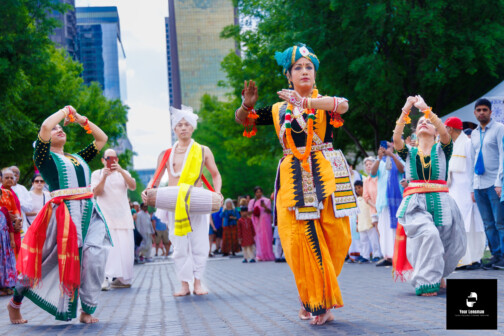The first floor gallery and the mezzanine level of the Crow Collection of Asian Art are currently closed for renovation and reinstallation, and this liminal state — the museum in transformation — feels like an appropriate setting for the work of Chinese artist and choreographer Shen Wei. Exhibited in the museum’s second floor back gallery, which is often dedicated to contemporary artists, Wei’s series of untitled abstract paintings hangs on four opposing walls. At first glance, there doesn’t seem to be much to the almost generic blur of gestural masses. The artist, who choreographed a section of the 2008 Beijing Olympic opening ceremony, works here primarily in oils, but with strategic use of resins and other synthetics to give his paintings dimension, sheen, and texture. Some are dripping and mysterious, dominated by black paint that frames meditative spaces. They suggest caves, grottos, or darkened clearings – magical landscapes, fantasies, or ethereal spaces. In a large piece that dominates a single wall, black and white paint tumbles into each other and pushes across the elongated, unstretched canvas in a tumultuous blur.
More interesting are the two works in which Shen Wei’s abstract dances remain more self-contained, resting against a white backdrop. In these, there is a tension created between the movement, accident, and violence of the painter’s process and the studied nature of each competition. The result is an attempt to balance the work between the literal and the abstract, the imagined and the unperceivable. Some parts of the painting look almost like Chinese watercolors, but as your eye tries to tease out its footing in the landscape, it is foiled by the lack of visual logic, the deliberate disruption of any actual, grounded trompe l’oeil.
The references to abstract expressionism – and Pollack in particular – as well as contemporary abstract painters (aspects of Albert Oehlen’s work comes to mind) are clear. But Wei’s work is most interesting when it is teasing its historical connection to Chinese masters. The wall text explains that the artist is a student of this artistic legacy, and that familiarity is clear in the way he is able to wrangle the great complexity of these large works in a way that still brings forward the subtlety and intricacy of the paintings most intimate moments. This effect is spoiled when the paintings become too mysterious, to emotive, surrealistic, and sentimental. But when they work, Wei’s painting suggests more than a trick of perception or a teasing out of the emotional quality of this dynamic and sensual approach to art making. The works appear as paintings caught in the centrifuge of a cross-cultural moment, liminal expressions of an artist – Chinese born, living in New York – through whom the contradictions of artistic and cultural traditions and history flow freely.






